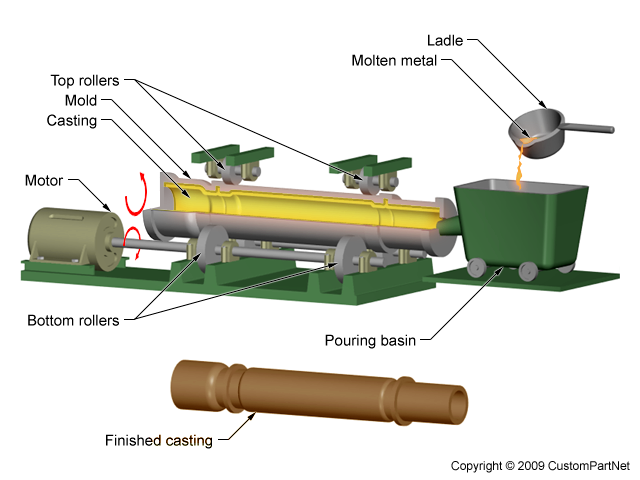Centrifugal casting, sometimes called rotocasting, is a metal casting process
that uses centrifugal force to form cylindrical parts. This differs from most metal casting
processes, which use gravity or pressure to fill the mold. In centrifugal casting, a permanent
mold made from steel, cast iron, or graphite is typically used. However, the use of expendable
sand molds is also possible. The casting process is usually performed on a horizontal centrifugal
casting machine (vertical machines are also available) and includes the following steps:
- Mold preparation - The walls of a cylindrical mold are first coated with a refractory ceramic coating, which involves a few steps (application, rotation, drying, and baking). Once prepared and secured, the mold is rotated about its axis at high speeds (300-3000 RPM), typically around 1000 RPM.
- Pouring - Molten metal is poured directly into the rotating mold, without the use of runners or a gating system. The centrifugal force drives the material towards the mold walls as the mold fills.
- Cooling - With all of the molten metal in the mold, the mold remains spinning as the metal cools. Cooling begins quickly at the mold walls and proceeds inwards.
- Casting removal - After the casting has cooled and solidified, the rotation is stopped and the casting can be removed.
- Finishing - While the centrifugal force drives the dense metal to the mold walls, any less dense impurities or bubbles flow to the inner surface of the casting. As a result, secondary processes such as machining, grinding, or sand-blasting, are required to clean and smooth the inner diameter of the part.
Centrifugal casting is used to produce axi-symmetric parts, such as cylinders or disks, which are
typically hollow. Due to the high centrifugal forces, these parts have a very fine grain on the
outer surface and possess mechanical properties approximately 30% greater than parts formed with
static casting methods. These parts may be cast from ferrous metals such as low alloy steel,
stainless steel, and iron, or from non-ferrous alloys such as aluminum, bronze, copper, magnesium,
and nickel. Centrifugal casting is performed in wide variety of industries, including aerospace,
industrial, marine, and power transmission. Typical parts include bearings, bushings, coils,
cylinder liners, nozzles, pipes/tubes, pressure vessels, pulleys, rings, and wheels.
Other Topics
IC engine,
Air
Standard Cycles, Method
of Ignition, Gear Types,
External
Gear Pump, mechanical
Engineering, Gears, spur gears,Helical
gears,herringbone
gear,Worm
gears,English
books,Photoshop
tutorials,Physics files,Thamizh,Manufacturing,Gears pdf,Computer
science,Harry
potter,Best
100 english books,Rack
and pinion,Face Gears,Involute
Splines,Straight
sided Spline, Bush
Roller Chains,IC
engine,Metal
Casting,Metal
Casting Terms,Categories
of metal casting processes,Sand
casting,SAND
Casting Quiz,Casting
patterns quiz,Sand
Casting Process,Patterns,Mechnical
Previous Years Gate Question Papers ,Mechanical-old-question-paper,Core
and Core Box,Shell
Moulding,Advantages
and disadvantages of shell molding casting,Permanent
mold casting,Investment
Casting,Die
Casting,Centrifugal
Casting

No comments:
Post a Comment